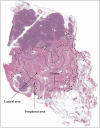Autophagy is activated in pancreatic cancer cells and correlates with poor patient outcome
- PMID: 18616529
- PMCID: PMC11159933
- DOI: 10.1111/j.1349-7006.2008.00893.x
Autophagy is activated in pancreatic cancer cells and correlates with poor patient outcome
Abstract
Because autonomous proliferating cancer cells are often exposed to hypoxic conditions, there must be an alternative metabolic pathway, such as autophagy, that allows them to obtain energy when both oxygen and glucose are depleted. We previously reported finding that autophagy actually contributes to cancer cell survival in colorectal cancers both in vitro and in vivo. Pancreatic cancer remains a devastating and poorly understood malignancy, and hypoxia in pancreatic cancers is known to increase their malignant potential. In the present study archival pancreatic cancer tissue was retrieved from 71 cases treated by curative pancreaticoduodenectomy. Autophagy was evaluated by immunohistochemical staining with anti-LC3 antibody, as LC3 is a key component of autophagy and has been used as a marker of autophagy. The results showed that strong LC3 expression in the peripheral area of pancreatic cancer tissue was correlated with a poor outcome (P = 0.0170) and short disease-free period (P = 0.0118). Two of the most significant correlations among the clinicopathological factors tested were found between the peripheral intensity level of LC3 expression and tumor size (P = 0.0098) or tumor necrosis (P = 0.0127). Activated autophagy is associated with pancreatic cancer cells, and autophagy is thought to be a response to factors in the cancer microenvironment, such as hypoxia and poor nutrient supply. This is the first study to report the clinicopathological significance of autophagy in pancreatic cancer.
Figures





References
-
- Kumar V, Cotran RS, Robbins SL. Robbins Pathologic Basis of Disease, 5th edn. Philadelphia: W.B. Saunders, 1992.
-
- Jain RK. Molecular regulation of vessel maturation. Nat Med 2003: 9: 685–93. - PubMed
-
- Vaupel P, Thews O, Hoeckel M. Treatment resistance of solid tumors: role of hypoxia and anemia. Med Oncol 2001; 18: 243–59. - PubMed
-
- Harris AL. Hypoxia – a key regulatory factor in tumour growth. Nat Rev Cancer 2002; 2: 38–47. - PubMed
-
- Koong AC, Mehta VK, Le QT et al . Pancreatic tumors show high levels of hypoxia. Int J Radiat Oncol Biol Phys 2000; 48: 919–22. - PubMed
Publication types
MeSH terms
Substances
LinkOut - more resources
Full Text Sources
Other Literature Sources
Medical

